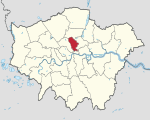Somers Town, London
Somers Town is an inner-city district in North West London. It has been strongly influenced by the three mainline north London railway termini: Euston (1838), St Pancras (1868) and King's Cross (1852), together with the Midland Railway Somers Town Goods Depot (1887) next to St Pancras, where the British Library now stands. Historically, the name "Somers Town" was used for the larger triangular area between the Pancras, Hampstead, and Euston Roads, but it is now taken to mean the rough rectangle centred on Chalton Street and bounded by Pancras Road, Euston Road, Eversholt Street, Crowndale Road, and the railway approaches to St Pancras station. Somers Town was originally within the medieval Parish of St Pancras, Middlesex, which in 1900 became the Metropolitan Borough of St Pancras. In 1965 the Borough of St Pancras was abolished and its area became part of the London Borough of Camden.
Excerpt from the Wikipedia article Somers Town, London (License: CC BY-SA 3.0, Authors).Somers Town, London
Phoenix Road, London Somers Town (London Borough of Camden)
Geographical coordinates (GPS) Address Nearby Places Show on map
Geographical coordinates (GPS)
| Latitude | Longitude |
|---|---|
| N 51.53097 ° | E -0.131498 ° |
Address
Phoenix Road
Phoenix Road
NW1 1HB London, Somers Town (London Borough of Camden)
England, United Kingdom
Open on Google Maps









